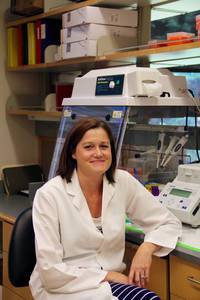Author Interviews, Nature, OBGYNE / 08.07.2015
IVF: Single Cell Analysis Allows Extremely Early Prediction Of Embryo Abnormalities
 MedicalResearch.com Interview with:
Shawn L. Chavez, Ph.D
Assistant Scientist/Professor
Oregon National Primate Research Center
OHSU | Oregon Health & Science University
Medical Research: What is the background for this study?
Dr. Chavez: This study builds upon a previous study also published in Nature Communications in 2012, which demonstrated that chromosomally normal and abnormal 4-cell human embryos can be largely distinguished by combining the timing intervals of the first three cell divisions with the presence or absence of a dynamic process called cellular fragmentation. The current study further combines time-lapse imaging of embryo development and full chromosome analysis with high throughout single-cell gene expression profiling to assess the chromosomal status of human embryos up to the 8-cell stage.
Medical Research: What are the main findings?
Dr. Chavez: The key findings of this research were that by measuring the duration of the first cell division, one can identify which embryos are chromosomally normal versus abnormal even earlier in development. By examining gene expression at a single-cell level, we were able to correlate the chromosomal make-up of an embryo to a subset of 12 genes that are activated prior to the first cell division. These genes likely came from either the egg or sperm and can be used to predict whether an embryo will be chromosomally normal or abnormal within the first 30 hours of development.
(more…)
MedicalResearch.com Interview with:
Shawn L. Chavez, Ph.D
Assistant Scientist/Professor
Oregon National Primate Research Center
OHSU | Oregon Health & Science University
Medical Research: What is the background for this study?
Dr. Chavez: This study builds upon a previous study also published in Nature Communications in 2012, which demonstrated that chromosomally normal and abnormal 4-cell human embryos can be largely distinguished by combining the timing intervals of the first three cell divisions with the presence or absence of a dynamic process called cellular fragmentation. The current study further combines time-lapse imaging of embryo development and full chromosome analysis with high throughout single-cell gene expression profiling to assess the chromosomal status of human embryos up to the 8-cell stage.
Medical Research: What are the main findings?
Dr. Chavez: The key findings of this research were that by measuring the duration of the first cell division, one can identify which embryos are chromosomally normal versus abnormal even earlier in development. By examining gene expression at a single-cell level, we were able to correlate the chromosomal make-up of an embryo to a subset of 12 genes that are activated prior to the first cell division. These genes likely came from either the egg or sperm and can be used to predict whether an embryo will be chromosomally normal or abnormal within the first 30 hours of development.
(more…)





















